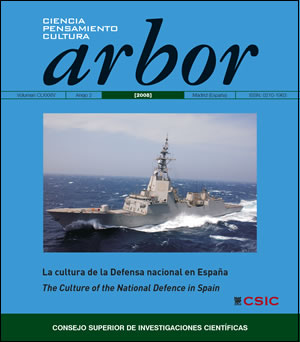El vínculo entre la innovación militar y civil: hacia un nuevo marco de relación
DOI:
https://doi.org/10.3989/arbor.2008.iA2.346Palabras clave:
Sistemas de innovación, innovación militar, políticas de defensa y seguridad, industrias de defensaResumen
El sistema de innovación militar que se configuró durante la Guerra Fría en los países occidentales se está viendo sujeto a un proceso de cambio que va a afectar de forma fundamental la relación con su entorno. El artículo presenta las principales características de este sistema que define como “cerrado”, y analiza las razones, tanto tecnológicas como estratégicas, que impulsan un cambio de modelo. El proceso de transición hacia un sistema más abierto, en el que no existen fronteras claras que delimiten el ámbito de lo que se está empezando a definir como “política de defensa y seguridad” será largo y complejo, y afectará al modo de generación y transmisión de conocimiento en su conjunto.
Descargas
Citas
Adams, G. (1982): The Politics of Defense Contracting. The Iron Triangle, New Brunswick and London, Transaction Publishers.
Altman, J. (2006): Military Nanotechnology: Potential Applications and Preventive Arms Control, London/New York, Routledge.
CORDIS (2006): Verheugen makes the case for security research in FP7, Retrieved 5 mayo 2006.
Crease, R. P. (1993): “The National Labs and Their Future,” Forum for Applied Research and Public Policy (Winter), 96-104.
Cuthbertson, I. (1983): Response of HMG to the questions posed in Working Paper 2 (Revision 2) of the UN Study on Military Research and Development, Arms Control and Disarmament Unit, Foreign and Commonwealth Office.
DeGrasse Jr., R. W. (1983): Military Expansion, Economic Decline. The Impact of Military Spending on U.S. Economic Performance, Armonk, New York, Sharpe.
DeLauer, R. (1984): “Technology Development and Transfer”, Commercializing Defense Related Technology, R. L. Kuhn, New York, Praeger.
Edwards, P. N. (1997): The Closed World. Computers and the Politics of Discourse in Cold War America, Cambridge, Ma., and London, The MT Press.
Eisenhower, D. D. (1961): “Farewell address by President Dwight D. Eisenhower”, Box 38, Speech Series, Papers of Dwight D. Eisenhower as President 1953-61, Eisenhower Library, National Archives and Records Administration.
Feldman, J. M. (1999): “Civilian diversification, leaming and insititutional change: growth through knowledge and power”, Environment and Planning, 31 (10), 1805-1824. doi:10.1068/a311805
Flamm, K. (1987): Targeting the Computer, Washington D.C., Brookings Institution. Galbraith, J. K. (1985): The New Industrial State, Boston, Houghton Mifflin.
Gansler, J. S. (1995): Defense Conversion. Transforming the Arsenal of Democracy, Cambridge, Ma. and London, MIT Press.
Hampson, F. (1989): Unguided missiles. How American buys its weapons, New York and London, W. W. Norton.
Kaldor, M. (1982): The Baroque Arsenal, London, Andre Deutsch.
Kaldor, M. (1999): New and Old Wars: Organized Violence in a Global Era, Standford, Standford University Press.
Lerner, J. (1992): “The Mobility of Corporate Scientists and Engineers between Civil and Defense Activities – Implications for Economic Competitiveness in the Post-Cold-War Era”, Defence Economics, 3 (3), 229-242.
Leslie, S. W. (1993): The Cold War and American Science. The Military-Industrial- Academic Complex at MIT and Standford, New York, Columbia University Press.
Manufacturing Studies Board (1987): Manufacturin Technology: Cornerstone of a Renewed Defense Industrial Base, Washington D.C., National Academy Press.
Melman, S. (1974): The Permanent War Economy. American Capitalism in Decline, New York, Simon and Schuster.
Mills, C. W. (1956): The Power Elite, New York, Oxford University Press.
Molas-Gallart, J. (2001): “Government policies and complex product systems: The case of defence standards and procurement”, International Journal of Aerospace Management, 1 (3), 268-280.
Molas-Gallart, J. y Tang, P. (2006): “Ownership matters: intellectual property, privatization and innovation”, Research Policy, 35 (2), 200-212. doi:10.1016/j.respol.2005.03.017
O’Connell Jr., C. F. (1985): “The Corps of Engineers and the Rise of Modem Management, 1827-1856”, Military Enterprise and Technological Change. Perspectives on the American Experience, M. R. Smith, Cambride, Ma. Y London, MIT Press, 87-116.
O’Connell, R. L. (1989): Of Arms and Men. A History of War, Weapons, and Aggres sion, New York, Oxford, Oxford University Press.
Peck, M. J. y Scherer, F. M. (1962): The Weapons Acquisition Process: An Economic Analysis, Boston, Ma., Graduate School of Business Administration, Harvard University.
Smith, M. R. (1987): “Army Ordenance and the ‘American System’ of Manufacturing, 1827-1856”, Military Enterprise and Technological Change, Perspectives on the American Experience, M. R. Smith, Cambridge, MA, MIT Press, 87-116.
Smith, M. R. (1987): “Introduction”, Military Enterprise and Technological Change. Perspectives on the American Experience, M. R. Smith, Cambridge, MA, MIT Press, 1-37.
Stear, E. B. (1997): “Defense Conversion at Boeing”, Defense Conversion Strategies, R. F. Dundervill, P. F. Gerity, A. K. Hyder y L. H. Luessen, Dordrecht, Kluwer Academic Publishers, 43-70.
Tarter, C. B. (1997): “Creating the Laboratory’s Future. Director’s Statement”, Creating the Laboratory’s Future. A Strategy for Lawrence Livermore National Laboratory, http://www.llnl.gov/director/ar128045/020director.htm.
U.S. Congress Office of Technology Assessment (1989): Holding the Edge: Maintainig the Defense Technology Base, U.S. Government Printing Office.
Descargas
Publicado
Cómo citar
Número
Sección
Licencia
Derechos de autor 2008 Consejo Superior de Investigaciones Científicas (CSIC)

Esta obra está bajo una licencia internacional Creative Commons Atribución 4.0.
© CSIC. Los originales publicados en las ediciones impresa y electrónica de esta Revista son propiedad del Consejo Superior de Investigaciones Científicas, siendo necesario citar la procedencia en cualquier reproducción parcial o total.
Salvo indicación contraria, todos los contenidos de la edición electrónica se distribuyen bajo una licencia de uso y distribución “Creative Commons Reconocimiento 4.0 Internacional ” (CC BY 4.0). Consulte la versión informativa y el texto legal de la licencia. Esta circunstancia ha de hacerse constar expresamente de esta forma cuando sea necesario.
No se autoriza el depósito en repositorios, páginas web personales o similares de cualquier otra versión distinta a la publicada por el editor.














